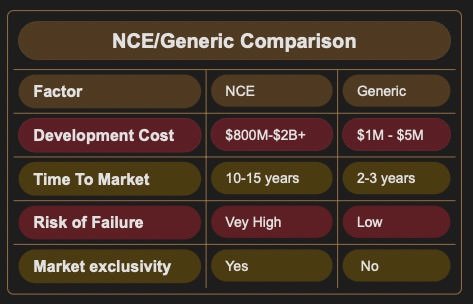1. How to bring your first small molecule, pharma product to the generic market
Part 1. Breaking Into Generics: How to Choose Your First Pharma Product Wisely
If you’re a start-up or a speciality pharma firm eyeing the generic drug market, you’re not alone—and you’re on to something. The path to bringing a generic drug to market is well-worn, yet still full of opportunity for those who know how to navigate it.
Unlike launching a New Chemical Entity (NCE), which can take a decade and cost billions, developing a generic drug can often be done in 2–3 years for a fraction of the investment. That’s a compelling business model—faster time to market, lower risk, and a clearer regulatory path. But make no mistake: the process is still a serious undertaking, and your success hinges on the choices you make early on—starting with which product to pursue.
Let’s explore the key decision points that will shape your generic drug strategy.
Why Generics, Not NCEs?
The answer is simple: risk and capital. NCEs promise blockbuster potential but come with daunting failure rates and astronomical costs. Generics, while more competitive and lower margin, are far more predictable and capital-efficient. Especially for new entrants, generics offer a logical on-ramp into the pharma industry.
Here’s a snapshot to illustrate the contrast:
No surprise, then, that generics are a go-to strategy for new pharma ventures.
Where to Begin? The Scope and the Strategy
While our development approach can be applied in many regulatory landscapes around the world, for the purposes of this series, we’ll focus on the U.S. FDA as our reference authority. Why? Because the FDA is classified as a Stringent Regulatory Authority (SRA)—a designation used by the World Health Organisation (WHO) (1) to identify national drug agencies that apply the highest standards of review. SRAs are trusted to uphold rigorous criteria for quality, safety, and efficacy, and their approvals are often recognised or relied upon by other regulatory bodies globally. Put simply: if your product meets FDA requirements, it’s well-positioned to meet the expectations of other leading markets too. The approval process under the FDA is the Abbreviated New Drug Application (ANDA) (2)
This guide focuses not on why you should enter the generics space—that’s your call—but on the how. Specifically: how to choose the right product. Whether you’re licensing, partnering, or developing from scratch, your decision rests on four pillars:
Product Source
Molecule Selection
Molecule Classification
Product Development Path
Let’s dig into each one.
1. Product Source: Where Will You Get Your Drug?
In the world of generics, a product must be an exact match to the Reference Listed Drug (RLD)—same active ingredient, dosage form, route of administration, strength, and intended use.
Once patents and exclusivities have expired (or been challenged), you have three sourcing options:
Option 1: License Existing Data: If a company has already developed the drug for another market (say, the EU), you might negotiate rights to repurpose that data for your U.S. FDA ANDA submission. Caution: not all data sets are FDA-ready.
Option 2: White-Label an Approved Generic: Partner with a company that already holds an FDA-approved ANDA, and market the product under your own label with a new NDC. Quick and low-risk—but your margin depends on the licensing deal.
Option 3: Develop Your Own Version: Build your own version based on public information about the RLD, and generate your own CTD (Common Technical Document). It’s the most work—but also the most rewarding in terms of ROI and autonomy.
💡 Pro tip: This third option is where firms like Oakley Business Development shine—helping clients reverse engineer and navigate development from the ground up.
2. Molecule Selection: Picking the Right Drug
Key Considerations:
Market Timing: Is exclusivity expired? Are patents still in force? Check both the FDA Orange Book and perform a patent search. (3)
Competition: Are you ready to enter a battle for a blockbuster? Or is it smarter to enter a mature, stabilized market with less resistance?
Portfolio Fit: Planning multiple products? Consider synergies in dosage forms or therapeutic areas. FDA’s GDUFA (4) fees favor economies of scale.
Supply Chain Alignment: Your product must match the channels you can access. Do you have wholesale distribution in place? Are you targeting retail chains or institutions?
3. Molecule Classification: Understand What You’re Handling
Before you commit to development, check the MSDS (Material Safety Data Sheet) for the molecule. You’ll want to flag:
Photosensitivity
Refrigeration/storage needs
Cytotoxicity
Teratogenicity
Controlled substance scheduling
Cephalosporin classification (special handling)
These aren’t dealbreakers, but they can impact your development, manufacturing, and marketing strategies.
Wrapping Up Part 1: Decision-Making With Clarity
Choosing your first generic product isn’t just a business decision—it’s a strategic one. The smoother your entry point, the better your learning curve, regulatory experience, and market traction.
In the next installment, we’ll dive into what it takes to develop your own version of a generic drug and submit it to the FDA via ANDA—building your own CTD from scratch.
Stay tuned for Part 2: Developing and Documenting Your Generic Drug for ANDA Approval.
Useful links:
1 https://www.who.int/news-room/questions-and-answers/item/who-listed-authorities
2 https://www.fda.gov/drugs/types-applications/abbreviated-new-drug-application-anda
3 https://www.fda.gov/drugs/development-approval-process-drugs/drug-approvals-and-1 databases
4 https://www.fda.gov/industry/generic-drug-user-fee-amendments/gdufa-iii-reauthorization


